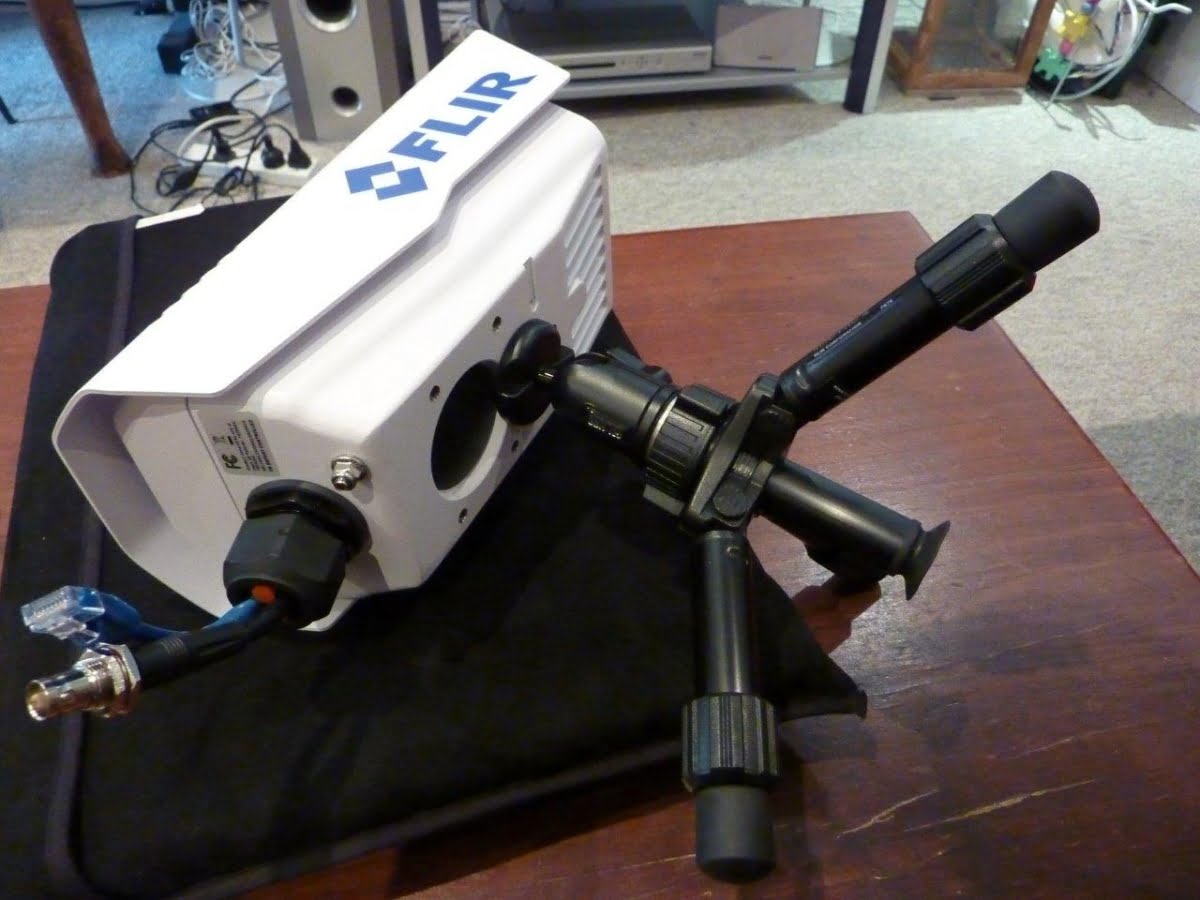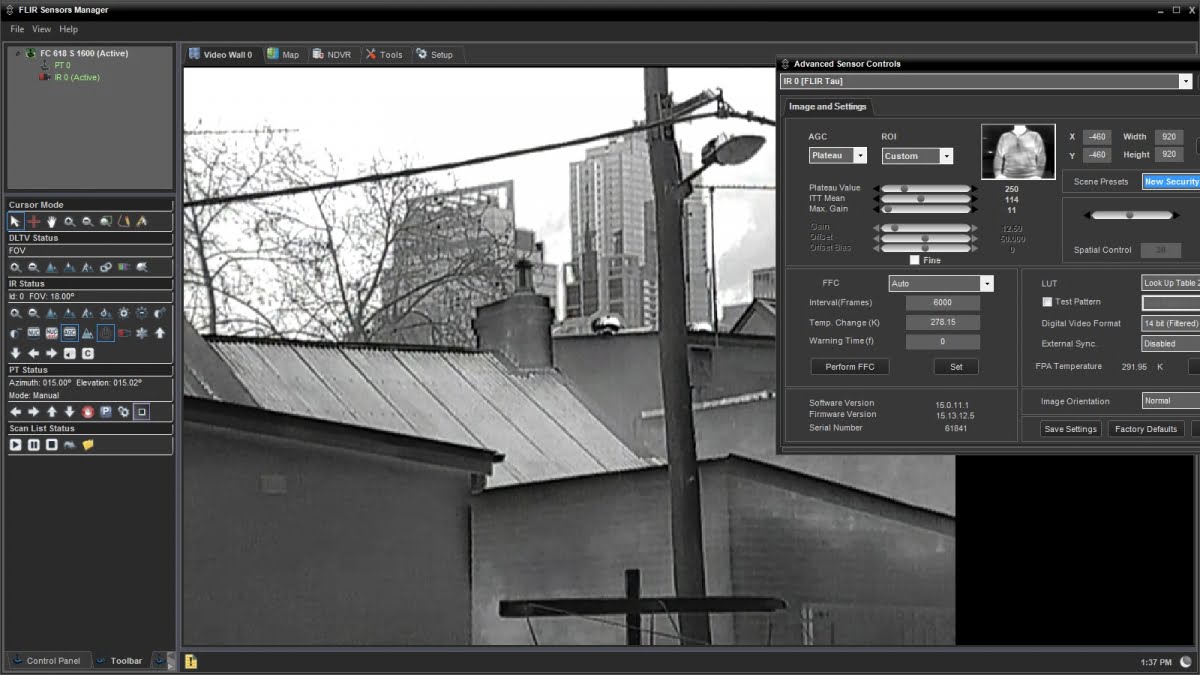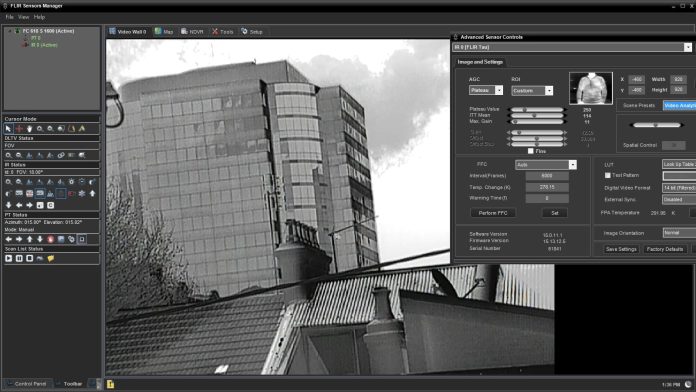WE’VE mentioned the Flir FC-Series S camera before in SEN but we’ve not test driven it and I’m very keen to see the camera in action when Peter De Ieso knocks on the office door. Flir products have an enviable reputation and holding the camera in my hands I can feel why.
In the past I’ve only rubbed shoulders with Flir’s big mounted units and they’re too big to hold in 2 hands. Touch gives a good sense of build quality, I think, and this aluminium bodied camera with its close fitting cable boot really is at an elevated level.
Before we get into testing the camera, let’s look at the specifications. For a start, this unit is 282 x 129 x 115mm in size with its sunshade on and it weighs around 2kg. Flir makes thermal gear for defence and law enforcement agencies and this quality spills over into the FC-Series S.
There’s an IP66 rating against dust and water. The camera has an operating range of -50 to 70C; it’s MIL-spec for shock, de-icing and anti-icing; has an IEC spec for vibration, can handle a 10g shock pulse with an 11ms half-sine and it has passed the FedEx free-fall drop test. There’s a sun and rain shade as well as a 3-year warranty on the camera and a 10-year warranty on the detector.
In terms of thermal performance, there are 2 resolutions – 640 x 480-pixel, and 320 x 240-pixel, as well as a range of lenses to suit a range of applications – wider angle or narrow to handle applications like fence lines. There are 11 models in the range, each with different lens parameters ranging from the FC-690 with a focal length of 7.5 mm and a field of view of 90×69 degrees to the FC-309, with a 35mm focal length and a 9×6-degree field of view.
Thermal detection is handled by a an uncooled VOx Microbolometer with an effective resolution of 76,800 (320 x 240) or 307,200 (640 x 280) and a thermal frame rate in PAL of 25 Hz or 8.33 Hz. Spectral range is 7.5 μm to 13.5 μm, there’s 4x continuous e-zoom, and the camera’s focus range is athermalized, focus-free. Streaming resolution options include D1, 4CIF, native, Q-native, CIF, and QCIF.
There’s thermal AGC modes, auto AGC, manual AGC, plateau equalization AGC, linear AGC, auto dynamic detail enhancement (DDE) and max gain setting. The thermal AGC and region of interest (ROI) have settings including default, presets and user-definable. Image uniformity optimization includes automatic flat field correction (FFC), as well as thermal and temporal triggers. The FC-Series S is a PoE+ camera with communication and power through a network cable, so it tucks easily into a network. There’s ONVIF 2.0 compliance for broad VMS support and there are multiple channels of streaming digital video in H.264, MPEG-4, or M-JPEG formats. Simultaneous digital and composite video output is also possible using the network and analogue connections.
“The first thing you notice holding the camera is that cable management is out of the back here, which means it’s shipped ready to go,” says De Ieso. “I just have to plug a PoE plus switch into that blue cable and the camera will power up. Alternatively, if you take the sunshield off, there are mounting points on top of the camera so it could be directly mounted to a pole from the top, bottom or back – there’s lots of flexibility. “The FC-Series S camera is MIL-spec against shock and vibration – just think of this as a commercially-priced product but still with a lot of the MIL-specs that Flir puts into its defence products.
“The same factory that makes our defence product makes our commercial gear and they use the same testing procedures, test beds and environmental chambers. The idea is to build a commercial product to defence standards at a lower cost. For instance, the camera body has excellent protective coatings. Our experience in defence has given us plenty of experience with the metal coatings that last longest. We’ve got some magical stuff,” he says.
Something else that has De Ieso excited is fields of view.
“With the FC-Series S we have a 90-degree field of view, compared to the F Series, which has a 45 degree field of view,” he explains. “While we do have 9-degree fields of view for fence line applications, the new wider fields of view mean that for the first time we are able to sell Flir cameras into applications we haven’t been able to before – embassies, smaller commercial premises and large homes.”
According to De Ieso, the FC-Series S camera is ideal for applications which demand a 90-degree field of view, yet have a shorter depth of field. That depth of field suits best because as lenses get wider angle, the thermal signal of people gets smaller and more difficult for effective video analysis.
If this sounds a bit confusing, one of Flir’s biggest assets is Raven, a web-based site planning tool that uses Google Maps to design a camera layout for any facility. Raven can handle 50 cameras at a time and it shows range and location for each camera. Especially neat, you can see detection coverage in advance and this lets you spot potential thermal dead zones and plan necessary overlaps.
Raven makes all the calculations for the technician. De Ieso runs through the process and it works very easily. You pop in an image of the site, plug in the planned camera specification and Raven knows that camera’s resolution and field of view and simply goes to work on creating a solution.
As part of helping installers plan a system, Raven also gives you an image of what a person will look like at a particular distance. It’s a useful feature – you can really establish what it is the camera will offer in an application. It looks to me as if this goes almost to the pixel level.
Flir FC Series S
Testing the camera
For single camera installations the FC-Series S is delivered with a single copy of Flir Sensors Manager. The software allows users to manage and control an FC-Series S camera in a TCP/IP network and we use it to drive the camera in our test. De Ieso sets to work setting the camera up in the SEN office. As he’s plugging cables in and booting up, De Ieso points out the simplicity of the setup process.
“If we give installers too many knobs and adjustments it’s easy to get lost – there are too many scene variables,” he explains. “Instead we have presets that make things easier and, depending on what installers are seeing in a field of view, they can simply make a preset selection.
“Something else we have added to the FC-Series S is Digital Detail Enhancement – a range of settings that allow users to get more detail out of an image. Flir has learnt how to process a thermal image to make it look as good as it possibly can look. This is done by optimising the image through a browser-based screen.”
De Ieso powers up and we look at the camera views on his laptop. The first thing that hits me as he swings the camera across the darkened office is that the Flir is picking up heat in the trio of dimmer light switches near the front door. The second thing I notice is gritty contrast. We’ve had the air conditioning set to 23 degrees all morning so surfaces in the office are uniformly warm but this camera is still discerning different temperatures and offering them to us as distinct variations of gray scale.
When I point this out, De Ieso starts talking temperature resolution and it’s interesting stuff.
“What you are talking about relates to NETD,” he explains. “In optical CCTV we talk about resolution and it’s the same principal in thermal – but you need to think of it as temperature resolution. This is how small a difference in temperature a thermal camera can see. Temperature resolution for a thermal camera is as important as pixel resolution for an optical camera.
“Our cameras are sensitive down to .05 degrees C, so if a wall is 30.00C and you place something in front of that wall, there’s 0.05C of a degree different and that will be a different shade of the 256-shade grey scale,” he says. “This finer resolution allows the FC-Series S to see more detail – we can see ripples on waves or folds of a dinner jacket.”
Having taken in the limited horizons of the SEN office, it’s time to point the FC-Series S outside. But before we do it’s worth mentioning WDR, something we are more familiar with as a characteristic of optical cameras. Flir’s thermal WDR is driven by a proprietary plateau histogram equalization image processing algorithm.
Simply put, typical thermal AGC corrections apply gray shades across the temperature range in a scene evenly. But in doing so, they lose image detail by applying grey shades to areas of no thermal interest. Conversely, Flir’s plateau histogram equalization concentrates available gray shades only on targets of interest. The result is better imaging across a wider dynamic range. According to De Ieso, this WDR capability is so effective it allows Flir cameras to see people even if the sun in the scene.
To check out this amazing WDR we take the camera out to the back of the SEN office and point it into full sun across the roof tops of Surry Hills. It’s about 1.45pm and the sun is still above the skyline. While De Ieso holds the camera, I peer at the screen of the laptop. Performance is impressive. We are getting good detail at serious distances. Even in daylight and with the sun right in the scene the foreground contrast of these images is unusually high.
The images are a bit like the oversaturated monochrome Kodak prints I have of myself as a kid, sitting on the stone lions in Cornwall Park in 1972. I’ve never seen a thermal camera deliver images that look like these. They are quite amazing and in hindsight I think they represent the beginning of a new phase of development with thermal cameras, a development that will see thermal resolution increase while contrast becomes more and more correctly rendered on display screens.
It’s very discerning isn’t it, I say. The depth of field in those images and their detail is so high.
“There are a couple of good reason for that,” says De Ieso. “Ordinarily when you have the sun in the image people do get washed out but Flir is able to handle this – this is our strength. We can still have high contrast images even with the sun actually in the image.”
I take another look at the laptop. The depth of field too, is most impressive. Thermal can feel 2-D, flat, blocky. Not with this Flir camera. It’s even getting the shine off the windows of the RTA building on down the hill on Elizabeth St – and while it may not look it in the photos here, that building is easily 250m away.
World Square is behind the lamp post, the sun over the crown of the building – distance is around 1000m, closer roofs are 25-30m
Next, De Ieso selects an even more challenging view. The back of the SEN office faces North West, allowing him to point the camera around to the North and directly into the sun, which is just above the World Square Building on Goulburn St, at least 1000m away. In the foreground, the first row of houses is 25-30m away and the trees on the other side of Belmore St are easily 50m away. For a thermal camera, the combination of depth of field and level of detail is extraordinarily good. We are getting the subtle contrast between surfaces – waves in corrugated iron, twigs on trees, colour differences between painted and brick surfaces, decoration on chimney pots, windows and window frames, TV antenna.
Well, it couldn’t get more demanding than that, I tell De Ieso, blinking in the blazing sun.
“No, it couldn’t and you can see the sun above the buildings is not effecting the image underneath it – that’s what we mean when we talk about WDR,” he says.
So there you have it – the Flir FC-Series S. Cost is $3000 – very competitive for a camera with this spec. As for the performance, it’s the best thermal image I’ve seen.
Fact File:
* Wide dynamic range
* High-performance, all-weather, industrial-rated system
* 12 VDC, 24 VAC, and two POE power input options
* IP and analog video outputs, IP and serial control interfaces
* Open IP standards for plug-and-play integration; ONVIF compliant
* Streaming digital video in H.264, MPEG-4, or M-JPEG formats
* Advanced thermal image processing with Digital Detail Enhancement.










